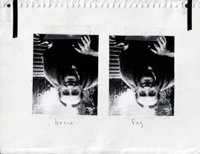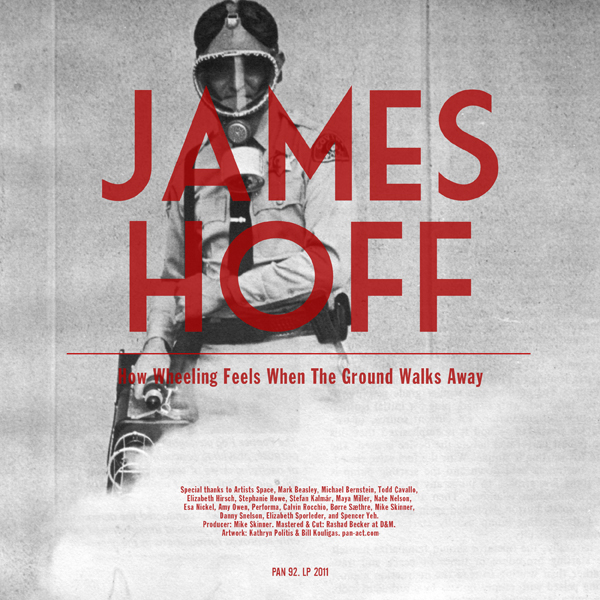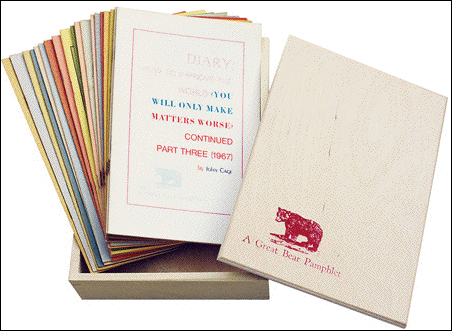 an event series at the
kelly writers house programmed by danny snelson featuring editorial practices in contemporary writing t e c h n o l o g i e s
|
RHM Foundation Artist Statement
Editorial practices and archival impulses guide my art-making processes across a diverse array of formats, including the artists' book, live performance, writing, painting, sculpture, sound art, and online distribution. Working in a variety of media, I often employ minor histories as source material, which are then re-worked or re-contextualized, forging new glances and unexpected relations that reflect on contemporary practice or further compound, expand, or expose the underlying history. As an archivist, I gather minor histories from public and private archives, some of which I have amassed and others to which I have gained access. This work extends, and runs parallel to, the editorial work I have carried out with the non-profit art organization Primary Information, which I co-founded in 2006. Using a variety of tactics, I often overlap and confuse source materials and techniques, embedding historical sources in new material to create fissures with their own unique histories. For example, a recent artists' book titled Topten (2008) takes as its source the monthly Top Ten column from Artforum magazine. This publication, carried out on the column's tenth anniversary, collected all Top Ten selections from 1998 to 2008. Reversing the strategies of Marcel Broodthaer's Un Coup de dés Jamais n'Abolira le Hasard, which famously replaces every line of Stéphane Mallarmé's poem of the same name with black rectangles, in Topten, all images accompanying the Artforum selections were blacked out. The result is ten years of art history reduced to text, a translation that inevitably highlights social connections and taste-making over aesthetic practice. However, I do not limit source material to art history and often combine this history with popular culture and politics in an effort to surface ruptures between the two. At Artists Space in 2009, I developed the performance How Wheeling Feels When the Ground Walks Away, an eight channel sound work created from sampling approximately 50 riots that took place at rock concerts and in the streets during political unrest in India, China, and Greece. Similar themes inform a recent series of paintings that take the Black Panther Coloring Book—a document published and distributed by the FBI in 1965 in an attempt to discredit the Black Panther Party—as a reference point at the nexus of these various discourses. This series reappropriates the images and text used by the FBI, with the colors reversed (from black on white to white on black) in an effort to underscore the publication as a white on black hate crime. These activities are supplemented by work on information systems and historical records. Under database culture, systems of distribution are paramount and I often challenge the predominant modes of dispersion in an attempt to question and circumvent the prevailing traditions. Over the last few years, I have developed a series of performative lectures under the title Inventory Arousal, which utilize two projectors—one playing video loops curated by other artists and one projecting slide images taken at random from a 4-terabyte archive of artists' writings, artists' books, sound art, and video art all obtained through social networking and peer-to-peer file sharing networks—and an improvised speech that links the two simultaneous projections anecdotally. This performance takes Vito Acconci's notion that words are the "perfect multiple" as its guiding principle and seeks to create art out of "thin air" by using the digital objects that archive art history as a series of cues or plants. What is created through the two-hour performance is a constantly shifting narrative of dematerialization in the guise of a neo-academic lecture on post-war art. Both the anecdotes I share, and the infinite variety of possible connections made by the audience become the multiples that the audience carries away with them. Upcoming and ongoing projects include a documentary film on the life of controversial East German filmmaker Sebastian Bleisch, a suite of redacted sculptures that question the role of the readymade in an era of digital distribution, and a new series of paintings that simultaneously investigate state lottery systems as a regressive tax on the poor and the role of game theory as a means for creating and distributing works of art. |
|




